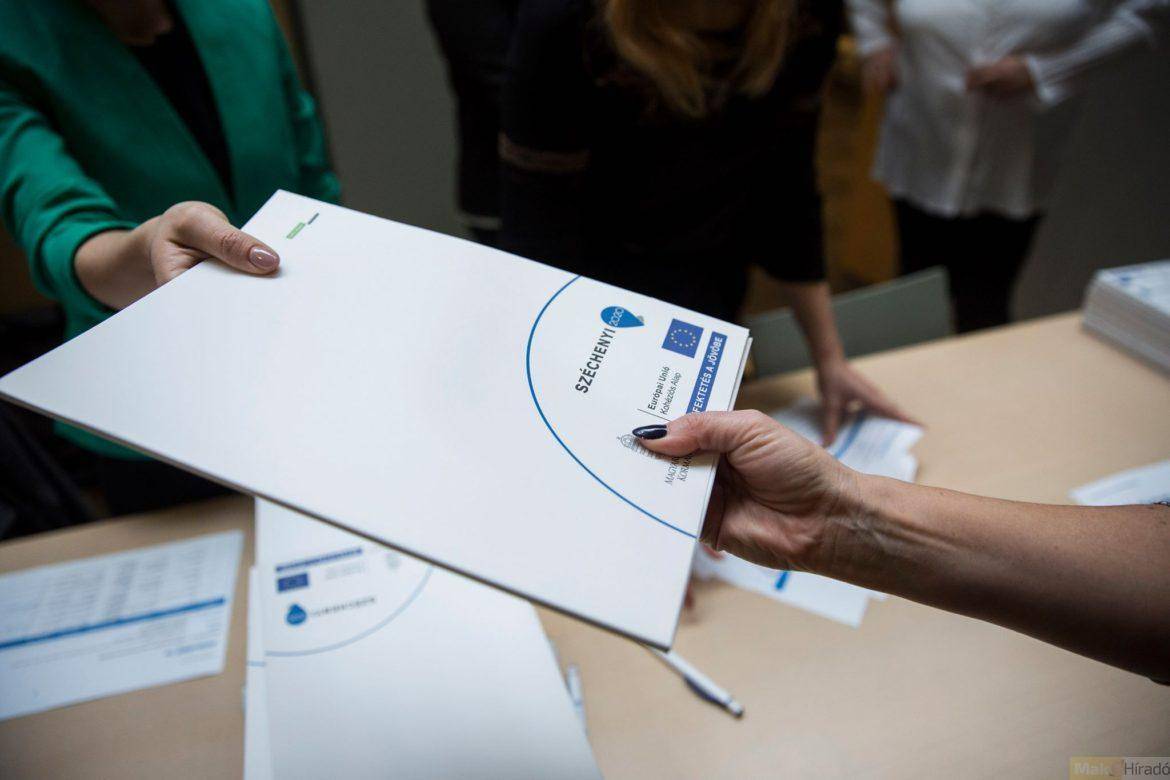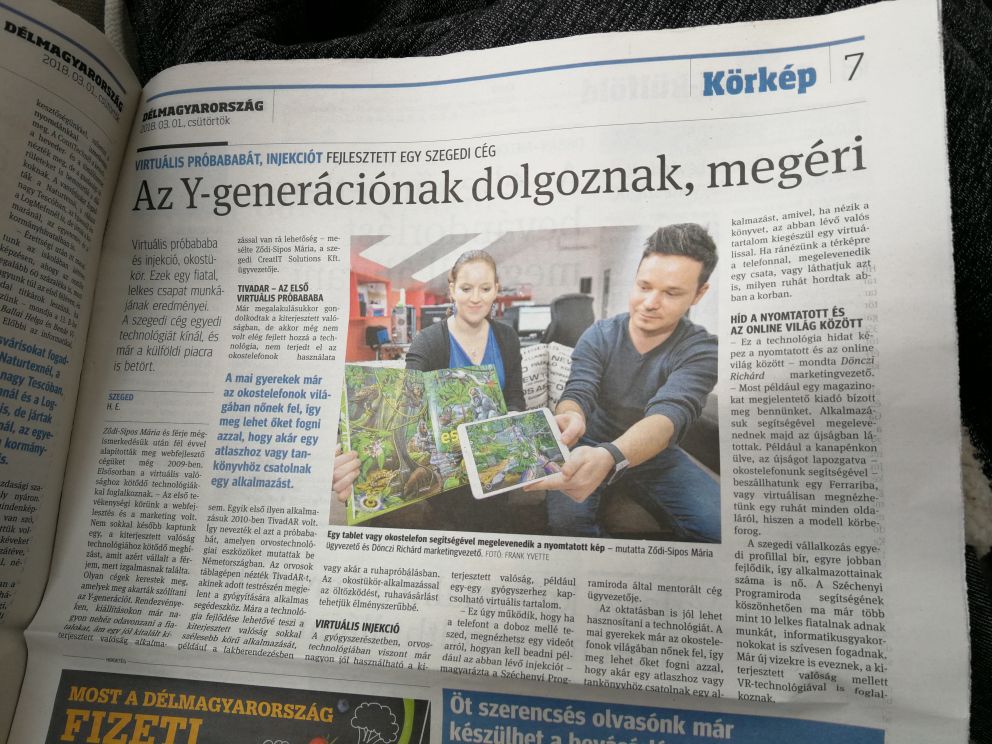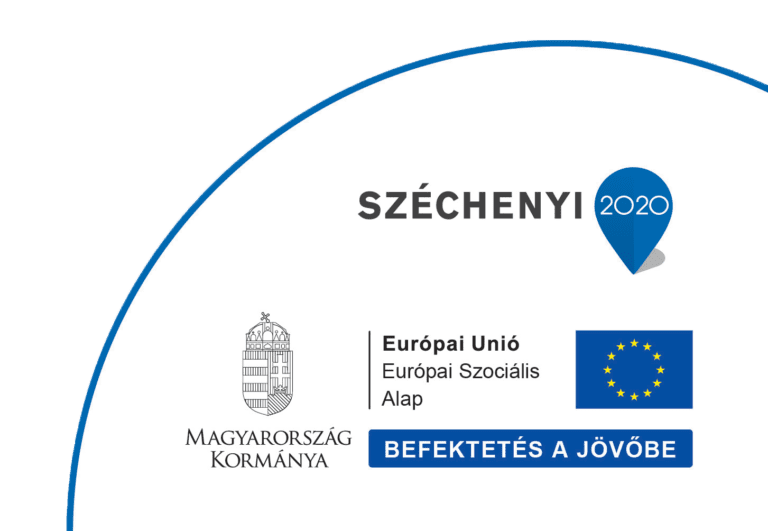
“What? They’re giving free help and advice?” – Széchényi program office interview
Our managing director, Mária Ződi-Sipos, had an interview with the Széchenyi Program Office, which you can read in its entirety here:
“What? They’re giving free help and advice? That’s great, let’s try it!” was Mária Ződi-Sipos’ reaction when she first heard about the Széchenyi Program Office’s services. She’s the managing director of CreatIT Solutions Ltd. This company, founded by her and her husband, had started to stagnate after its initial momentum but thanks to the Economic Development Operative Program (Hungarian acronym: GOP) and the Office’s free help, they were able to keep growing. Their Hungarian virtual reality company has been operating ceaselessly for the last 8 years, not only providing jobs for 11 people, but also achieving some considerable successes as they prepare to break into the international market.
Makó Híradó (Makó News) – Noémi Konopás
Noémi Konopás: Where did the idea for your company come from? Tell us about launching the company.
Mária Ződi-Sipos: I had been working as a marketing manager for HVG Állásbörze (job fair), a job search website, when I first met my husband in 2009. He was a freelance web-developer, taking commissions from various companies. We quickly connected with each other both intellectually and professionally. We brought forward the idea, if we think we’re each so clever in our own areas, why don’t we do something together? This is how we came up with the plan to make an enterprise together. We decided he would take care of the development and I would do the creative part: marketing and PR. We soon put our idea into action, creating the company just half a year later. Business was booming just 18 months after launch, when we had so many orders that we had to put a lot more serious work into our business. Moreover, thanks to our family’s support, we were able to move from Budapest to Szeged, the city along the border in which both of us could work on CreatIt as our full-time job.
Noémi Konopás: How hard was it to launch an enterprise? What was the toughest period following the foundation of the business?
Mária Ződi-Sipos: When we first started receiving too many orders for the two of us to do them all, but we didn’t yet have the capital to hire full-time colleagues. It was difficult to balance and we felt that we were at the point of either bailing out or sinking. Fortunately, two kinds of help arrived along with the difficulties. We started employing and training students. We looked for competence rather than experience, which worked extremely well. Fortunately, the University of Szeged has a good IT program and the internship program also provided us with a wide spread to choose from. Sadly, this abundance no longer exists: the labor market is very small and it’s hard to find good people, but we were lucky at the start. Several of the colleagues we hired then are still with us. The second thing that helped us was the GOP-2.2.4-12-2012-0242 grant, which enabled us to start employing full-time colleagues. Since then, the company has been growing nicely.
Noémi Konopás: This grant proposal was submitted with the help of the Széchenyi Program Office, right? How did you find the company?
Mária Ződi-Sipos: A few years ago, the Csongrád County Chamber of Commerce and Industry held an event for young entrepreneurs. The Program Office gave one of the lectures there, that’s where I first heard about the company. I thought ‘What? They are giving free help and advice? That’s great, let’s try it!’And it worked.
Noémi Konopás: Which projects specifically did CreatIt and the Széchenyi Programme Office (SZPI) work on together?
Mária Ződi-Sipos: I’ve been in contact with Andrea Tóth, our advisor at the SZPI office in Szeged, for about five or six years now. When the Economic Development Operative Program that I mentioned earlier was first published, we thought it’d be a great opportunity to stabilize our company. We didn’t want to get help from a grant writer. I thought, “I can write and I can read the call for grant proposals. What could go wrong? Why shouldn’t we give it a try?” In the end, our application succeeded. Later we got the hang of it so much that two of our Southern Plains Operative Program (Hungarian acronym: DAOP) grant applications also succeeded. Our latest submission was for the Economic Development and Innovation Operative Program (Hungarian acronym GINOP) grant for support in entering foreign markets. We’re awaiting their decision.
Noémi Konopás: You mentioned grant writers. What’s the difference between the assistance SZPI provides and the assistance that grant writing companies provide?
Mária Ződi-Sipos: Some time before our first application, my father-in-law’s company commissioned a grant writing company. We saw that they didn’t really add anything worthwhile to the process. All they did was some administrative tasks. They neither took part in the thought process about how to word the grant application nor helped us plan it out. We thought it was a crime to pay so much for a little bit of administrative assistance, so we decided that next time we would do it by ourselves, taking advantage of the free help provided by SZPI.
Noémi Konopás: What did the SZPI colleague help with exactly?
Mária Ződi-Sipos: She helped a lot with double-checking and with various calculations. Somehow system calculations were always different on the expense-resource side than according to my Excel calculations because the two programs handled decimal fractions differently for some reason, so I always got stuck at this point. She also helped figure out whether we met the requirements at all, and she never hesitated to help even with minor technical issues. One time, I wrote a very long list of questions around midnight, and the Programme Office’s advisor answered my e-mail the very next day. I could reach her at any time; she replied almost instantly and came by in person when needed. She did her job very conscientiously. I think she did more for us than she was obligated to. We worked together wonderfully. I am glad that I found this office.”
Noémi Konopás: There are many companies in Hungary who are active in the same field as CreatIT. In what ways is CreatIT different from these companies?
Mária Ződi-Sipos: Our first activities were web development and marketing. Shortly thereafter, we got an order that required augmented reality technology, which my husband accepted on the basis of “why not?”. It sparked both of our interests. From a marketing perspective, I thought it could be a very useful way to speak to millennials at exhibitions and fairs, and that it was also very marketable. As a developer, my husband saw that few people in Hungary were working with this technology, so we repositioned the company accordingly. Although development and marketing have remained part of our activities, virtual reality technology has become our main focus: this is where we can create something truly unique, and provide custom applications for our clients. Off the shelf software can rarely be adapted to meet client’s needs, so specification has become our starting point. Nowadays, we have reached the point where our own competitors send us subcontract projects.
Noémi Konopás: What potential have you seen for augmented reality technology, outside of foreign examples?
Mária Ződi-Sipos: I have worked a lot with the printed press, because my first degree was in journalism. And later when I studied marketing, I was more interested in offline journalism at first. However, I realized in the course of my work that offline media is losing its attraction and is looking for a way to break out. It was only a matter of time before a market demand would emerge for newspapers or magazine content that could provide extra information about a given subject – for example videos attached to advertisements, interviews or promotional games. The app allows us to measure how many people are reached by the content or the ad, which is a great tool for attracting advertisers as well. We were already thinking about augmented reality around 2009-2010, but the technology was just not there at the time, even smartphones weren’t in common use yet. Modern technology has finally reached the point where this can be implemented beautifully, so print media is starting to show an interest in augmented reality. In book publishing, this process started somewhat earlier.
Noémi Konopás: What do you think is the secret to market success? How much does customization matter?
Mária Ződi-Sipos: We have a great position here in Szeged with regards to the workforce. It is nice to have the university so close to us. Being located in a country town gives us a value for money advantage on our competitors as well, since we can offer lower prices than similar companies in the capital. On the other hand, providing a service rather than a product is difficult, since it means we lack a steady income that can be planned for: we are always having to balance things to have a sufficient number of orders and to gain returning clients. It’s like a game of chess.
Noémi Konopás: Has your company developed anything unique, something that is characteristic of CreatIT, that has never been done before by anyone else?
Mária Ződi-Sipos: All of our commissions are custom-made, except for web development, where we often build on frameworks and templates. However, all our virtual and augmented reality apps are custom; there are no two alike.
Noémi Konopás: Virtual reality is already being used in the real estate market. Do you have any such apps?
Mária Ződi-Sipos: There are already several services available on the market that allow us to virtually tour a property in 360° degrees. We would like to develop this further to meet our client’s needs. We’ll give the real estate agent some hardware with which they can pan around the whole property. Then they could upload the finished, cloud-based version to their online platform and share it everywhere.
Noémi Konopás: Product presentation using augmented reality. What exactly does this mean?
Mária Ződi-Sipos: Augmented reality is typically used for stimulating consumption and for promotional purposes, mainly in shopping malls. Its primary role is to catch and keep people’s attention. For example, passersby could see themselves on external projectors and interact with 3D models, or even with actual products. Or, for instance, there is an interactive mirror. A customer touches a piece of clothing and they can see how it would look on them without having to actually try it on.
Noémi Konopás: How widespread are these smart mirrors you mentioned?
Mária Ződi-Sipos: They are much more common abroad than in Hungary. We made a mirror like this and it was very popular. Customers felt the technology was innovative.
Noémi Konopás: How do you come up with ideas for new applications?
Mária Ződi-Sipos: We often adapt ideas from abroad where these applications are getting more and more widespread. We takes these ideas further, improve them, give them extra thought. Of course, we have tons of projects of our own. Augmented and virtual reality-based development is limited only by our imagination. This approach is well-suited for a wide range of applications from logistics to the entertainment industry. We have lots of internal ideas ready to be developed. For example, in a newsletter last year, we mentioned an app plan for “furnishing your own home”. About a year later, one of the big home furnishing companies remembered our idea and published an app with really great graphics. My husband has a list of about a hundred ideas; most of these have been implemented in recent years whether by us, or by others.
Noémi Konopás: Ideas flow very quickly and I am sure it’s frustrating when you come up with a great idea only to realize that somebody else has already created it.
Mária Ződi-Sipos: Sure, that’s happened a few times, but I’m always saying this only confirms that we are on the right path and that our ideas are innovative.
Noémi Konopás: How many employees do you have right now?
Mária Ződi-Sipos: 11 in total, of which there are 5 full-time employees, 4 student workers through the Student Co-Op, and 2 or 3 regular subcontractors.
Noémi Konopás: How much is your revenue?
Mária Ződi-Sipos: We had 35 million HUF in revenues last year. We had been expecting more by the end of the year, but then we had a baby, so I dropped out of rotation.
Noémi Konopás: Marketing matters this much?
Mária Ződi-Sipos: Yes, probably. This year we set out with a goal of 50 million HUF. We have never had steep growth; our company’s profits have always grown nice and steadily.
Noémi Konopás: I believe you have been planning to enter the international market. Where are you in this process?
Mária Ződi-Sipos: We haven’t advertised the company or its services until now. Clients found us through recommendations before. I was always proud of not having a separate marketing budget, and that we didn’t have to deal with promotions until last year, when we rebranded: we launched a new website and created new videos, sponsorship presentations, and business cards. We endeavored to have a professional brand that would be marketable internationally as well.
Since our workforce has reached a number that requires continuous work to maintain, we realized that it’s no longer enough to succeed in the Hungarian market, that we need to do so abroad as well, where we can also deliver a good value for money. By now, our colleagues’ proficiency in English is such that client communication about operative problems doesn’t pose any difficulty.
We have also applied for grant support from the Economic Development and Innovation Operative Program for our entrance into the international market, though we haven’t heard back yet. Some of our colleagues participated in two international events pertaining to our line of work, one in Vienna and the other in Bristol. We gained lots of new partnerships at these events. Many of those clients are still in touch with us, or have already given us commissions. Additionally, we are getting in touch with big advertising agencies, international IT companies, and competitors to get involved in their work as a subcontractor or collaborator. Although this seems to progress slowly, it’s a good direction for the future of our company.
Noémi Konopás: What are you most proud of in your company?
Mária Ződi-Sipos: Our low personnel turnover. People who join us and fit in with the team tend to stay for a very long time. I am also pleased to see that our colleagues are just as motivated as we are; they are truly passionate about what we are doing together, and I’m glad to work with them. We have created a positive atmosphere with good team-spirit. I love that our crew has become like a family. It feels great to have been able to create a stable company that will be viable for the foreseeable future. CreatIT is our first child, then we had two more: one is now 4 years old, and the other 4 months old.
Noémi Konopás: What kinds of companies would you recommend the SZPI office’s services to?
Mária Ződi-Sipos: To anyone who is considering writing a grant application on their own, or who does not have the budget, or who has an affinity and entrepreneurial mindset for grant writing.
Noémi Konopás: What are the essentials of a successful grant application?
Mária Ződi-Sipos: A good idea, a precise plan, attention, foresight, and thoroughness.
Source: https://makohirado.hu/2018/02/20/micsoda-hogy-ingyen-segitenek-tanacsot-adnak/



